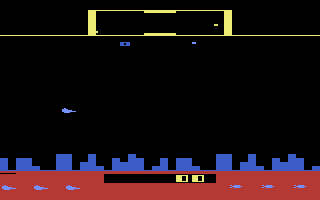 Digital Press hooked up with ace
Atari ex-programmer Bob Polaro recently on the Internet. Our Email conversations resulted
in the following exclusive interview.
Digital Press hooked up with ace
Atari ex-programmer Bob Polaro recently on the Internet. Our Email conversations resulted
in the following exclusive interview.Dinner With Bob
Polaro
Interview by Al Backiel
 Digital Press hooked up with ace
Atari ex-programmer Bob Polaro recently on the Internet. Our Email conversations resulted
in the following exclusive interview.
Digital Press hooked up with ace
Atari ex-programmer Bob Polaro recently on the Internet. Our Email conversations resulted
in the following exclusive interview.
DP: Where did you receive your programming education?
BP: In high school and college. Mostly using Basic, Cobol, Fortran and Assembly on mainframes.
DP: How did you land a job at Atari?
BP: I had just left Commodore - programming the Pet computer. Atari was just starting to develop on the Atari 800 and they were interested in me doing similar applications, games.
DP: What was it like at Atari? Was it laid back? Strict? Was there a dress code? Impossible deadlines? What did you guys do for amusement?
BP: On my first interview I wore a blue vested suit. On my second they insisted I be more informal. Atari was very loose and friendly with a lot of cool people working there that liked to party, and play games, but also take great pride in the design process of video games. It was a lot like a college atmosphere. We were mostly the same age at that time (early to late twenties). More than just colleagues, we were friends. We had lots of space to develop with, large labs to work in as well as offices to escape to. We had no dress code. Most of us occasionally worked to the wee hours in the morning. We used to play volleyball out in the sand court a couple of days a week. Had a hot tub, sauna and work out room and frequent keg parties. Our building on Borregas in Sunnyvale was nicknamed the "Country Club". I remember when a half dozen suits came into my lab to see my 2600 volleyball game while I was wearing a tank top, shorts, and sandals. They would then inquire about a round ball.
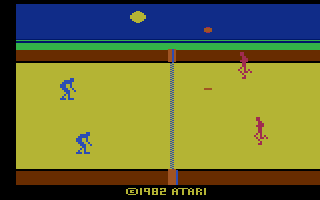 DP: Who were some of your
colleagues? Do you still maintain contact with them?
DP: Who were some of your
colleagues? Do you still maintain contact with them?
BP: I pretty much had most of my friends there. We were all about the same age and single so we hung out together for offsite after work activities. I would say I currently stay in contact with about 20% of them. After all most of us left over 14 years ago!
DP: How long were you at Atari? Were you there when it was sold to Warner Bros.? Tramiel?
BP: I was there ’78 to ’84. Best 6 years of my life. I left shortly after Tramiel bought the company.
DP: How long did it take you to code and test Defender (2600)? How did you manage to do so much with so little storage?
BP: About 6 months was the standard for most of these games. We were able to get away with such little ROM(4K) and RAM(128 bytes) because we didn’t stress graphics as much as game play. The low-res playfield had a lot do with it as well. Most of the space was for logic. The drawbacks for the machine were the cycle limitations per scan line (called the 76 cycle blues) and only having 5 objects to move around: 2 missiles, 2 players, and a ball. If the calculations in the game loop exceeded a certain time the screen would roll, which was considered a fatal. Surprisingly enough however, we had lots of colors because all the lums were available.
DP: What are the steps to doing a coin-op translation like Defender? Do you get use of a coin-op to play? Do you get a copy of the original source code to look at? Do you work with video tapes or screen captures?
BP: We had all the games in house that we translated to. The main challenge with Defender was getting it to work and feel right using only the joystick rather than all those buttons. A number of people actually preferred this version because of the ease of play. Hardcore gamers obviously like the coin-op version. The long range scanner was also quite tricky. The only thing I would have done different if I had to do it over again would be to make more of an effort to avoid the ship from disappearing when firing. The original source is usually useless to us because of the major design changes. Screen captures were also unnecessary. We just need the game play, then we add the graphics. Usually a whole game would be completed by just using boxes as the objects.
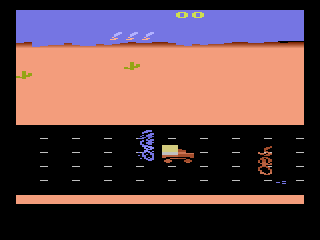 DP: By now most of
our readers know how to find your hidden initials in Defender. What is the significance of
the "25"? (ed. note.. During the 25th wave, the 25th shot from the 25th line of
resolution or the top causes all enemies to change temporarily to BP).
DP: By now most of
our readers know how to find your hidden initials in Defender. What is the significance of
the "25"? (ed. note.. During the 25th wave, the 25th shot from the 25th line of
resolution or the top causes all enemies to change temporarily to BP).
BP: If you caught a humanoid and hold him at exactly 25 lines above the city in the 25th wave the aliens would change to BP’s as long as you held it there. I think most people would find this by accident by seeing the aliens flash as they passed that line.
DP: I was one of the first gamers to find your hidden initials in Desert Falcon (2600). (ed. note ...Go for a swim around the northern part of the lake while carrying a super power, preferably invincibility). Having reported it to Computer Entertainer newsletter back in Mar '88. Are there any "easter eggs" tucked away in Sprintmaster or Road Runner or any other of your other 2600 games? If so, how does one access them?
BP: Real Sports Volleyball had a kind of easter egg in that if you waited long enough, the screen would get darker and darker and a small shark would come out and go across the horizon. (ed. note…After loading, hit reset until you get to serve the ball. Red team/ left court. Then do nothing! Admire the sunset. When the sun has disappeared below the horizon, a shark fin can be seen crossing the horizon as darkness sets in. This takes about 8 minutes. Also notice that holding down reset momentarily causes 2 bouncing balls).
DP: Speaking of Road Runner for the 2600, why did it take Atari so long to release this game? The game is copyrighted 1989, yet it did not hit the stores until mid-1992? And even then, mostly overseas.
BP: Road Runner was my last 2600 game (and probably one of the last in the industry) and I don’t know if the market was clearly defined at that time. I had contracted that game so I was separated from the inside scoop. It didn’t take more than 6 months to develop so I guess it was on hold for a while.
DP: Was Stunt Cycle based on the coin-op or that early dedicated video game console that came with the motorcycle handle bars?
BP: Stunt Cycle was not only my first attempt at the 2600, but one of the first machine language programs I ever wrote. It was based on the dedicated console. It was only 2K. The graphics were later changed to emulate the show "Dukes of Hazzard" using an orange car and a lake instead of the motorcycle and buses. The problem was the game used the paddle controller.
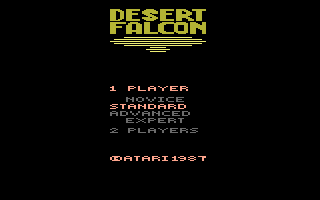 DP: I noticed that you
worked on several games which were stopped and put aside. Today Holey Moley, Dukes of
Hazzard, Stunt Cycle and Bugs Bunny exist only as prototypes. Were you given other
priorities? Did the licensing fall through? Did you find these decisions frustrating?
DP: I noticed that you
worked on several games which were stopped and put aside. Today Holey Moley, Dukes of
Hazzard, Stunt Cycle and Bugs Bunny exist only as prototypes. Were you given other
priorities? Did the licensing fall through? Did you find these decisions frustrating?
BP: I always found it frustrating to put my heart and soul into a project and then have it shelved. Holey Moley was never really finished. It used the large keypad. I thought Bugs Bunny had the cutest graphics of any 2600 game. It play tested with teenagers against "Snoopy and the Red Baron", a very unfair comparison. It had very simple but fun game play which would have been well suited for younger kids and uncoordinated adults.
DP: I see from your list that you did several fishing games on various platforms for THQ. Are you a fishing buff in real life?
BP: I took the job at T.H.Q. because I thought the idea of a fishing game on the SNES and Sega Genesis was a great refreshing change from the slew of fighting and side scrolling games. These were about bass fishing, but I’ve never caught a bass in my life!
I do enjoy ocean fishing and have caught my share of large salmon. I didn’t even know the names of any lures before I started that project.
DP: You did several programs while at Atari for their 800 computer. Mugwump sounds interesting. What was that one about?
BP: The full name was "Hide the Mugwump". Kind of like a cutesy battleship game with kiddie animal characters.
DP: The 2600 version of Rampage that you did for Activision. Were you actually working there or was this done as a freelance assignment?
BP: I did that on a contract basis for the newly named Mediagenic. Just like all the other Rampage games they did, the debug stage took longer than anticipated due to the chaotic nature of the game.
DP: What was the status of BOBCO and the geography lessons? Was this your own corporation?
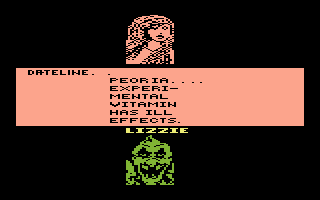 BP: Some former Atari friends of
mine started a small company developing educational software for the C64 using a Kaypro 10
as a development environment. I decided to do the same thing while licensing some of their
tools. I took a year developing "World Geography" which was similar in style to
"States in Capitals" only on a "global" scale. I had the world’s
best graphic artist, Alan Murphy do the graphics for me on a royalty basis ( He was the
one that jokingly put BOBCO on the screen, which soon became the company name). I tried to
get it published but found it was too "educational" for most game companies.
Interestingly enough I approached Broderbund at the time but they were already working on
a soon too be very popular geography game. They suggested to me to make the whole game
multiple choice rather than a keyboard input based game. I eventually published it myself
and spent a year marketing it by going to shows and getting distribution. I had it
available in German and Spanish, and licensed a version to AriolaSoft, a subsidiary of
Bertlesmann in Europe. I sold a fair amount that way and even had it in catalogs opposite
Broderbund’s Product. I eventually wrote it for the Apple II, but was too late for
the industry.
BP: Some former Atari friends of
mine started a small company developing educational software for the C64 using a Kaypro 10
as a development environment. I decided to do the same thing while licensing some of their
tools. I took a year developing "World Geography" which was similar in style to
"States in Capitals" only on a "global" scale. I had the world’s
best graphic artist, Alan Murphy do the graphics for me on a royalty basis ( He was the
one that jokingly put BOBCO on the screen, which soon became the company name). I tried to
get it published but found it was too "educational" for most game companies.
Interestingly enough I approached Broderbund at the time but they were already working on
a soon too be very popular geography game. They suggested to me to make the whole game
multiple choice rather than a keyboard input based game. I eventually published it myself
and spent a year marketing it by going to shows and getting distribution. I had it
available in German and Spanish, and licensed a version to AriolaSoft, a subsidiary of
Bertlesmann in Europe. I sold a fair amount that way and even had it in catalogs opposite
Broderbund’s Product. I eventually wrote it for the Apple II, but was too late for
the industry.
DP: On a more technical note, but in layman terms. What are the basic differences between coding in: BASIC, 6502, 65816, and 68000?
BP: Basic is the high level language that most people first dabble with when starting to program. 6502 is the 8 bit assembly language used for the Atari, Commodore and Apple II computers. It consists of mostly loading and storing, using three letter commands such as LDA and STA. The 85816 was the 16 bit version of 6502 used in the SNES. The 68000 was used in the Sega Genesis.
DP: It looks like nowadays you are creating PC-based programs in C Language. How much different is this environment from the old days? Have you given any thoughts to doing something else for the older systems?
BP: The main difference now is that I’m doing video redemption games which kind of go against the grain of my last 15 years of video game design. These games are designed solely based on arcade type earnings which means the game should only last a few minutes as you pump in quarters. The game play has to be as simple as possible. I’m used to games taking 40 hours to play in the homes. The advantage is it only takes about 2-3 months to finish a game and the debugging stage is fairly short due to the extremely simple and brief game playing time.
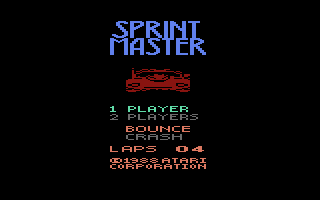 I think I might want to do a
2600 game again for old time sake.
I think I might want to do a
2600 game again for old time sake.
DP: What memories to you have of your colleagues?
BP: Here’s a short list (excuse my spelling):
Dennis Koble: His decision to have me work on the 2600.
Jim Huether, Warren Robinette: Showing me the ropes to the 2600.
Rob Fulop: A feature a day. The wisest of the bunch: A great professional poker player.
Carla Meninski: The best of the few female designers. Dancing and singing in the labs.
Tod Frye: Climbing the walls!
Howard Scott Warshaw: Holding a styrofoam cup, flicking ashes into it doing his schtick.
Alan Miller: The most mellow of them all.
Dave Johnson: Drank milk for his ulcer, became one of my best friends.
Rick Mauer: The work of art of Space Invaders. The start of the new revolution.
Brad Stewart: His bad puns.
Marylyn Churchill: Did all the art for 8 games at a time.
Bill Aspromonte: Greatly upstaged Defender with Stargate. Great waterskier.
Sandy Maywald/Nick Turner: His fish tank.
Jim Andreasen: Lining up his cigarette butts. Always mellow and smiling.
Rob Zydyble: Biked to work on Matilda. A real Berkeley boy.
Eric Manghise: Great hats.
Andy Fuchs: His sound room.
Tom Reuterdaul: Great crepes (remember, Jim?).
Frank Hauseman: His Centipede game.
Doug Neubeur: Star Raiders was our favorite game. He was a chip designer.
Matt Hubbard: Winner on Jeopardy. Backgammon king. Lead singer in a punk band.
David Crane: Cranked them out.
Jan Boem: Running around carrying eproms.
Larry Kaplan: Air-Sea Battle. The best feel of any game.
Dan Hitchens: His "Berzerk" laugh.
Joe Copson: His vet pictures.
George Simcock: Going into Real Estate?
Mark Hahn: Called me a "beach weasel" and said "Life sucks then you die!". He really wasn’t a negative person though.
These were the smartest, friendliest, funniest and most diverse creative people I’ve ever known.
![]()
Return to Digital Press Home
Last updated: Thursday, May 27, 2004 01:56 PM